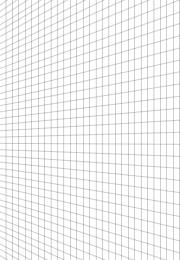Perspective Drawing Paper with Vanishing Point Grids
Perspective drawing paper (also called vanishing point paper or perspective grid paper) is a specialized template featuring guide lines that converge toward one or more vanishing points. These pre-drawn grids eliminate the need to manually calculate perspective lines, helping artists, architects, students, and designers create accurate drawings with realistic depth and dimension.
Unlike regular graph paper which uses a flat grid, perspective paper provides angular guide lines that follow the rules of linear perspective. This makes it invaluable for architectural sketches, technical illustrations, art education, and any drawing that requires accurate spatial relationships.
When to Use Perspective Drawing Paper
Use perspective paper instead of regular graph paper when your drawing needs to show depth, distance, or three-dimensional space. It's essential for:
-
Architecture and Urban Design:
Building elevations, street scenes, interior spaces, and architectural renderings
-
Art and Illustration:
Background environments, room interiors, product design sketches, and comic book panels
-
Education:
Teaching perspective drawing fundamentals, art class exercises, and technical drawing courses
-
Technical Drawing:
Engineering illustrations, product mockups, and presentation sketches
Popular Perspective Paper Configurations
Each configuration serves different drawing needs. Here are the most popular setups for common use cases:
Architecture & Building Drawing
-
Building Facades:
Use
One-Point · Center VP · Portrait
for symmetrical building fronts, storefronts, and architectural elevations. The center vanishing point creates balanced compositions perfect for facade studies.
-
Street Scenes:
Use
One-Point · Bottom Center · Landscape
for roads extending into the distance. The bottom-center vanishing point creates a natural forward-looking perspective.
-
Corner Buildings:
Use
Two-Point · Standard Horizon · Landscape
to show both sides of buildings realistically. Two-point perspective is the standard for architectural corner views.
-
City Skylines:
Use
Two-Point · High Horizon · Landscape
for elevated urban views looking down at cityscapes. The high horizon line creates a bird's eye perspective.
-
Skyscrapers:
Use
Three-Point · Worm's Eye · Portrait
for dramatic upward views of tall buildings. Three-point perspective with vertical convergence emphasizes height.
Tips for Using Perspective Drawing Paper
- Start by identifying your horizon line and vanishing points on the printed template
- Use the guide lines for major structural elements, then add details freehand
- Keep the perspective grid visible but light—don't let it overpower your drawing
- For complex scenes, you may need to extend lines beyond the printed guides
- Practice with one-point perspective before moving to two-point and three-point
- The grid lines are guides, not rules—adjust as needed for artistic effect

